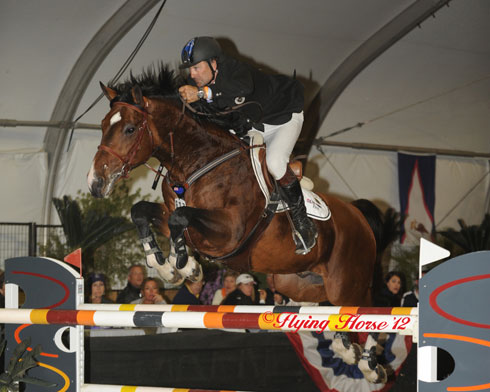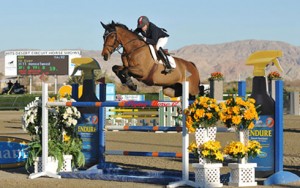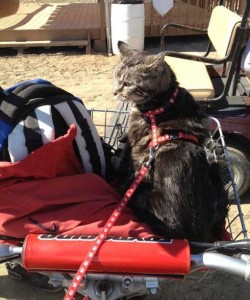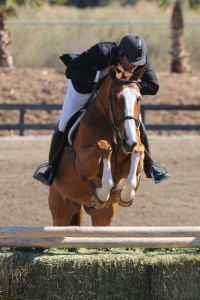Outwoods Outperforms at HITS
By Paula Parisi March 1, 2012
Duncan McFarlane and Mr. Whoopy win the $53,000 Purina Mills Grand Prix CSI-W 2* on Feb. 11. (Flying Horse Photography)
The first half of the HITS Desert Circuit was dominated by Outwoods Farm, the Castro Valley, CA-based sales and training outfit run by Helen McNaught and Duncan McFarlane. With McNaught riding Caballo and Lariccello, and McFarlane aboard Mr. Whoopy, the duo amassed a total of 13 placings over the course of eight grand prix over four weeks, including three wins.
“It’s been a very good show for us,” McNaught said. “Caballo is jumping phenomenally and Lariccello is too.” She also sold three horses the first half of the show.
The positivity is particularly sweet for McNaught, who at HITS made her return to the show ring following a serious injury. She broke her neck in a schooling accident at her barn in October. “This is my first show after I fell off at home. The doctor told me I could ride again in January and here I am. Who would have thought I would have been back so fast?”
Drama during the first half of HITS included more than just McNaught’s bravura comeback. There was an EHV-1 scare, triggered by a case at a nearby polo facility and the loss and subsequent return of McNaught’s tabby cat, who fled after a pit bull attack, triggering what amounted to a week-long reality show on Facebook.
“He’s named Lucky for a reason,” McNaught chuckled. Lucky’s fate seems curiously intertwined with HITS. “He jumped on the truck on the way to the show in Saugerties. They found him on the next stop, 100 miles later. He was only about 6 weeks old. I stuck a collar on him and locked him up at night. When we left, he was still there, so we took him home.”
McFarlane has been enjoying time in the spotlight, too, with back-to-back wins in the last grand prix of Desert Circuit II, a $53,000 World Cup qualifier at night in the indoor area, and the first of DC III, a $32,000 classic on the outdoor field.
In addition to winning the second World Cup Qualifier at HITS, McFarlane came in second in the first, won by Francie Steinwedell-Carvin and Taunus the prior week. “They were similar sized tracks, but the first one had very simple distance problems because it was the first West Coast qualifier of the year. The second one was trickier, and the problems were a little more snarly.”
While McFarlane is trying to earn enough points to qualify for the World Cup in April, his homeland of New Zealand, part of the Eastern European League, didn’t qualify for a team or individual Olympic show jumping slot. “The country didn’t want to spend the money to send horses to Aachen to try to qualify last year, so they’re not participating,” he said.
McFarlane, who has dual citizenship, said he has considered “switching teams” to ride for the U.S., but the decision is complicated by a two-year Olympic stand-down rule. As it stands, he is ninth on the North American League’s World Cup points list, according to Ryegate Show Services.
As a service to riders, HITS holds its World Cup qualifiers in a tented indoor arena that better approximates the conditions they typically encounter at the World Cup Finals in Europe. This year’s World Cup Finals for show jumping and dressage will be held April 19-22 at the Indoor Brabant in ‘s-Hertogenbosch, the Netherlands.
High-Perf Jumper Numbers Down
Due to the tight turns and highly technical nature of the qualifiers, these classes represent the top tier of the high-performance show jumping riders, a category that saw entries down in the first half of the Desert Circuit. “While our show overall is bigger this year, the number of high performance jumpers has been disappointing,” HITS president and CEO Tom Struzzieri said as the circuit progressed to its sold-out second half.

Jill Henselwood and IV Ever took the blue in two grand prix during the first half of HITS. (Flying Horse Photography)
“We had 2,000 stalls sold, but only 15 horses competing in our World Cup Qualifiers,” he said, pointing out that in years past there have never been fewer than 30 starters in those classes. Jill Henselwood is one rider who is glad she made the trek from Canada, winning two grand prix on IV Ever, and hoping to grab the attention of her nation’s Olympic observers.
On the night of HITS’ Feb. 4 CSI-W grand prix there were more than 80 horses in the World Cup qualifying class at the Winter Equestrian Festival in Florida. Part of that is due to the prize money: the WEF offers more than $6 million between Jan. 11 and April 1. HITS doles out about $2 million from Jan. 24 to March 11.
Another factor is that the U.S. Olympic selection trials are held during WEF and some elite riders―even those who know they don’t have a chance of making one of the team’s four slots― are attracted by the prestige of those classes and the thrill of competing against the top international riders. The West Coast’s Lucy Davis, Saer Coulter and Chris Pratt are among those who competed in Thermal last year but opted for Florida in 2012. Richard Spooner, Ashlee Bond and Kirsten Coe are Californians who now spend virtually the entire winter in Wellington, FL.
Pratt did the first half of the season in Florida and is attending HITS second-half, when 2,900 horses will be stabled at the Desert Horse Park. “I go to Florida to focus on my own riding. The competition there is really tough, a lot of Europeans,” Pratt said.
“With HITS, it’s back to business. I only brought two horses to Florida, but I’m bringing 18 to Thermal. It’s a great opportunity to develop young horses. They have a lot of different rings to ride in and lots of room. It’s not 5,000 horses packed into one facility, like in Palm Beach. The footing is nice, and the jumps are great. There may be less prize money, but it’s less expensive to get there, too, which my clients certainly appreciate.”
Hunters Pick Up the Slack
Struzzieri said what the show has lost in its high performance jumper numbers, it’s more than made up for in the hunter categories. “We have seven hunter rings going this year. I don’t think that’s happened since our first year in Thermal. It’s really nice to see horses in Hunter Ring 7 again.”
John Bragg of Laguna Beach set the pace on the early circuit, winning two out of the first three $5,000 Devoucoux Hunter Prix. Nick Haness of San Clemente had a strong showing at the top of the second half, nabbing three of the top six ribbons in the Feb. 26 hunter prix.
Vendors are also displaying wares at HITS in higher numbers than years past. “Everything is up across the board, with the exception of the high performance jumpers,” Struzzieri said. “Last year we were up 10% overall, this year it’s about 20% over last year―that’s 30% in two years, which is in lockstep with the rest of the economy,” he said, citing a tenuous general economic turnaround. “Our show in Ocala was up this year too, but not by 20%.
“Arizona is soft. That show draws primarily from a local clientele. I think the take away is people want to go where there’s a good-sized horse show and more economic activity, a better chance to pick up new clients and buy and sell horses.” That’s why they call it show business!
For full results and more information about HITS, visit www.hitsshows.com.
Short URL: https://theequestriannews.com/?p=8148




